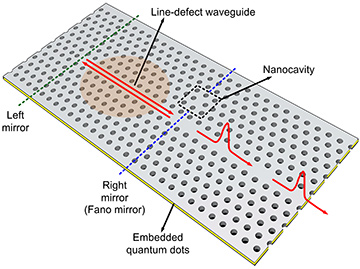 Schematic of Fano laser, based on an InP photonic-crystal membrane with embedded InAs quantum dots as the active region. The laser cavity consists of a waveguide terminated by a broadband left mirror and a narrowband right mirror realized by Fano interference between a waveguide continuum mode and a discrete mode in a side-coupled nanocavity. The laser emits short pulses along the waveguide to the right. Colored spot is the area in which optical pumping is performed. [Reprinted by permission from Macmillan Publishers Ltd., Nat. Photon. 11, 81 (2017), ©2017]
Schematic of Fano laser, based on an InP photonic-crystal membrane with embedded InAs quantum dots as the active region. The laser cavity consists of a waveguide terminated by a broadband left mirror and a narrowband right mirror realized by Fano interference between a waveguide continuum mode and a discrete mode in a side-coupled nanocavity. The laser emits short pulses along the waveguide to the right. Colored spot is the area in which optical pumping is performed. [Reprinted by permission from Macmillan Publishers Ltd., Nat. Photon. 11, 81 (2017), ©2017]
In conventional lasers, the active medium is commonly sandwiched between two mirrors. Semiconductor laser cavities rely on various types of mirror arrangements, including Fresnel reflection at a cleaved facet, mode coupling in a high-contrast grating, or Bragg reflection from a periodic stack of layers.1 This year, we demonstrated a novel type of nanolaser with a “mirrorless” end.2 The back-reflection in our laser design comes not from a mirror but from a Fano resonance—a special form of resonance named after the Italian-American physicist Ugo Fano, who first described it in 1961.3
In our structure, the Fano resonance is formed by wave interference between the continuum of modes of a photonic-crystal open waveguide and the discrete resonance of a photonic-crystal nanocavity.2 At resonance, the paths of light through the nanocavity and the waveguide interfere destructively. This leads to a virtual “mirror” with high reflectivity, creating a bound state in the continuum.
In previous theoretical work, we showed that such a Fano laser, if realized, had the potential to be modulated at frequencies above 1 THz—two orders of magnitude better than the best lasers today.4 In our experiments, we found that the Fano mirror leads to additional unique laser characteristics. The laser is single mode due to the Fano mirror’s narrowband characteristics, compared with conventional laser mirrors. However, the large dispersion of the Fano mirror, combined with optical nonlinearities, means that the laser can also operate in a completely different regime, in which it modulates itself to generate a self-sustained train of short pulses (on the order of 10 ps) at gigahertz frequencies, an effect previously observed only in macroscopic lasers.
Apart from the first demonstration of a new laser concept, the Fano laser, our work also provides the first observation of self-pulsing in a nanolaser. Self-pulsation may be a simple and cost-effective way of generating ultrashort pulse trains without any external driving electronics.5 The Fano laser has rich physics and may lead to new applications in different areas, such as ultra-high-speed and low-energy communications and sensing.
Researchers
Y. Yu, W. Xue, E. Semenova, K. Yvind and J. Mork, DTU Fotonik, Technical University of Denmark, Kongens Lyngby, Denmark
References
1. A.E. Siegman. Lasers (Univ. Sci. Books, 1986).
2. Y. Yu et al. Nat. Photon. 11, 81 (2017).
3. U. Fano. Phys. Rev. 124, 1866 (1961).
4. J. Mork et al. Phys. Rev. Lett. 113, 163901 (2014).
5. U. Keller et al. IEEE J. Quantum Electron. 2, 435 (1996).
